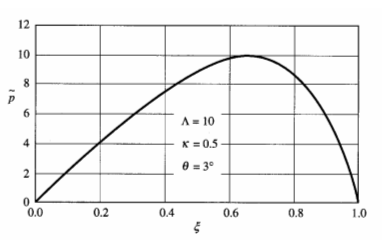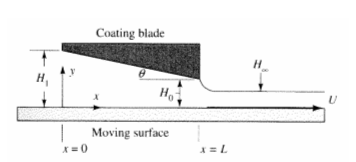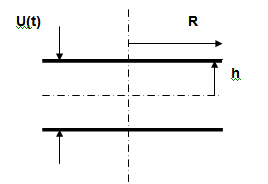| << Chapter < Page | Chapter >> Page > |
Substituting the velocity profile into the above integral gives us the Reynolds equation for lubrication flow.
Integration of this equation gives,
A second integration gives,
where the constant of integration has to satisfy the boundary conditions,

The role of the lubrication layer is to maintain a separation of the two surfaces in the presence of a load such that asperities (roughness) on the surfaces do not make contact. The load on the bearing is equal to the integral of the normal stress over the bearing surface. If the change in gap-thickness is small compared to the length, as assumed here, the normal stress is approximately equal to the pressure. If the gap-thickness is monotone decreasing, the pressure will be greater than ambient pressure inside the bearing. However, if the gap-thickness in monotone increasing, the pressure will be less than ambient in the bearing and it will have no load bearing capacity. If the gap-thickness is not monotone, then the pressure may be greater than ambient in some places and less than ambient in other places. If the bearing is designed to be load bearing, then a long section of decreasing gap-thickness and a short section of increasing thickness is desired. If the bearing is designed to be a scraper as piston rings then both sections of changing thickness will be short as to limit the amount of liquid passing through the gap. Gas entering the low-pressure region at the exit of the bearing surface prevents bearing surface contact from negative pressures.
The analysis for the slider bearing can also be used to design an apparatus for depositing a uniform coating of a liquid on a substrate.

Squeeze films. When two objects approach each other in a fluid their relative velocity is slowed as the resistance increases for the fluid leaving the gap. Here the relative velocity of the surface is in the normal direction rather than in the parallel direction as in the case of the slider bearing. This type of flow is important in the coalescence of emulsion droplets or foam bubbles. In the case of coalescence, hydrodynamics govern the dynamics of the approach of the surfaces to each other until the thinning is accelerated or retarded by surface forces (i.e., disjoining pressure).
We will derive the classical Reynolds drainage of a liquid between two parallel disks of radius approaching each other. The configuration of the system is shown below.

The system is symmetrical about its axis and the mid-plane. The thickness, , is one-half of the distance between the disks and the velocity of each disk, , is one-half of the approach velocity of the two disks. This nomenclature may be awkward but with this nomenclature, the solution also applies to the thinning of a liquid film between a solid surface and a gas bubble having zero shear stress at the interface. The velocity of approach of the disks may not be constant but rather the force pressing the disks together may be constant. Because of the symmetry, we will analyze the upper half-space with cylindrical polar coordinates. The system is axisymmetrical so the independent variables are , , . The equations of motion and continuity equation in cylindrical polar coordinates are

Notification Switch
Would you like to follow the 'Transport phenomena' conversation and receive update notifications?